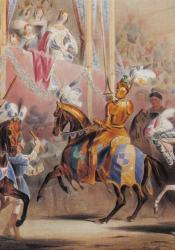North Ayrshire (Irvine), Scotland
The Eglinton Tournament took place on the Eglinton grounds in Ayrshire, which is approximately in the area of what is now mapped as Eglinton Country Park (in the modern day).
The estate consited of the arena, where the tournament was held, the Eglinton bridge, which was part of the procession from the castle to the arena grounds, and the Eglinton castle, which is where the banquet and ball was held at the end of the tournament.
On the 150th anniversary of the tournament, the grounds were opened to the public as the Eglinton Country Park, where the main attraction is the ruins of the castle that remains. It was at this time there was also a reenactment of the tournament held.
The park now consists of many features along with the ruins for the castle. There are gardens, walking trails, children's play areas, the land where an old school was demolished, two mills, the training camps from World War II, cottages, stables, ponds, bridges, and unique wildlife. Some of the fauna is even held under conservative guidelines for their unique and diverse qualities: the sorbus arranensis (flower), the puff-ball mushroom, the jelly ear, and the oyster mushroom.
The Eglinton Tournament might be something to draw attention and attraction to the park, but there are no limits to what can be found.
Works Cited
“Home.” Eglinton Country Park, www.north-ayrshire.gov.uk/leisure-parks-and-events/eglinton/eglinton-hom.... Accessed 9 Oct. 2020.
Parent Map
Coordinates
Longitude: -4.666872024536

